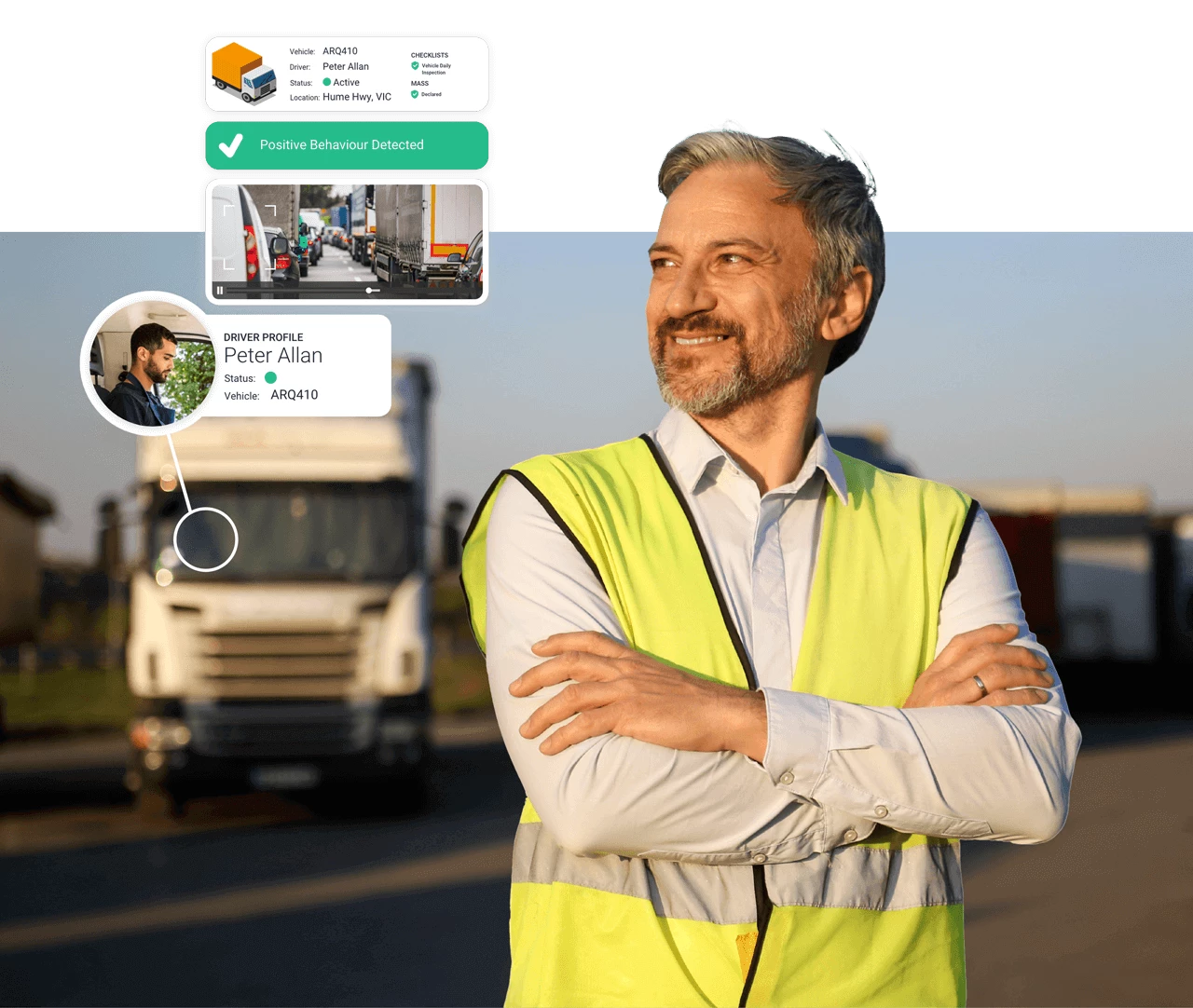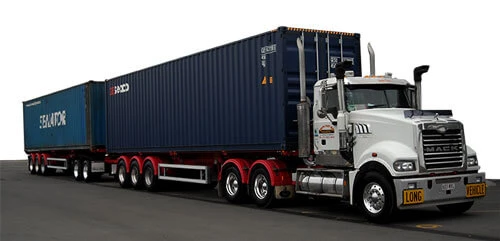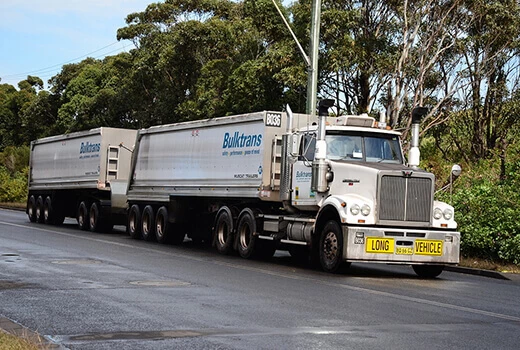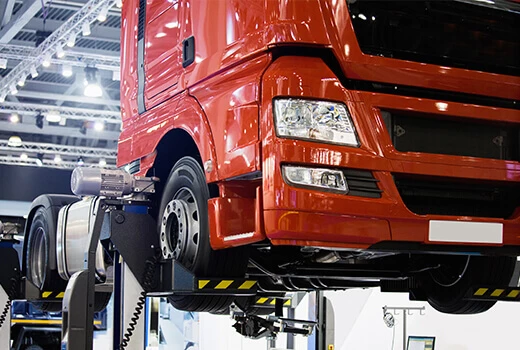Using Type-Approved smart on-board weighing systems, it gives your transport operation the opportunity to increase payload and utilise vehicle combinations that have not been previously possible, including PBS A-Doubles, Truck & Dogs, and Road Trains. The benefits don't stop there

What can Smart OBM and Teletrac Navman bring you? Truckloads. Smart OBM systems are digitally connected on-board weighing systems to your vehicles that bring real-time mass information to improve productivity instantly.

Smart OBM systems are devices that use digital technology to collect and transmit the mass of axle groups and calculate the gross vehicle mass in a reliable way direct from the vehicle to the vehicle's cab for the driver, as well as to the back-office, instantaneously.
This data is collected by Application Service Providers (ASP) who are certified through the National Telematics Framework to provide certified access to programs like the Intelligent Access Program (IAP) or the Telematics Monitoring Application (TMA).
Transport operators will need a Smart OBM system if required by a road manager, regulator or other party, specified as a condition for heavy vehicle access.
As there is no requirement for certificate-based evidence for prosecution purposes, Smart OBM used in conjunction with TMA can deliver a high quality of vehicle monitoring without many overheads associated with chain of evidence for

Real-time OBM weighing systems are able to measure the mass of axle groups and calculate the gross vehicle mass of a vehicle at any point in time. OBM systems are often referred to as on-board weigh scales or electronic weighing systems, and are widely used across the surface transport sector commercial, contractual and regulatory purposes.
TCA grants approval for OBM systems against strict functional and technical specifications that contains performance-based requirements. Approval may be in the form of type-approval or an acceptable equivalent approval mechanism.
Teletrac Navman is a TCA type-approved and authorised Smart OBM service provider, and has a long and rich history in working with the TCA, scale providers, and transport operators since the inception of the program.
Teletrac Navman’s type-approved telematics device, paired with TN360, an AI-enabled fleet and compliance management solution, you gain a completely integrated system that provides a central hub for all your applications alongside real-time mass direct from your vehicles. Via telematics and integration, information is shared to bring all your work together so that productivity is maximised.
Bulktrans operate out of Pt Kembla in New South Wales transporting every category of dry bulk goods. Masters road is one of the main arterial roads coming into the port to return to the Bulktrans’ depots.
Read more about their journey »
The vehicle combinations utilised are not permitted to return via Masters road, an 8km round journey for all drivers.
Bulktrans approached RMS with the plan of fitting approved on-board scales under the IAP program to its vehicle to travel on the Masters road route. Provided ability to prove vehicles are travelling unladen in real-time.
Access to the HML network improved payload by an additional 2.5 tonnes per load, 10% distance and time saving and instant reduction in fuel and operational costs.
Based on 14,000 loads per month, an additional 420,000 tonnes saved 12,500 trips in a year.
Teletrac Navman is a certified Application Service Provider that supports OBM systems amongst many other regulatory programs. Our telematics technology required to enable and integrate with on-board weighing systems are TCA type-approved.
Transport Certification Australia (TCA) has a strict set of guidelines that OBM supplies of digital scales must pass through to become approved. At Teletrac Navman, we are proud to partner with a range of these suppliers to ensure you have options to allow you to make the right choice for your business.
We've collated some of the most important questions we've fielded over the years to help you better understand what it is, and what's involved. If you do have further questions, please get in touch and we'll be happy to guide you in your journey to Smart OBM.

Using calibrated scales fitted to the vehicle, OBM systems monitor all the axle groups to provide the mass readings in real-time. Businesses are able to prove to road managers that they are compliant, can manage risk to infrastructure, and allow specific access to transport operators on their managed road network. This includes, bridges, last-mile roads and local ports, which can be crucial when you require specific vehicles to complete specific tasks.
Access to the program is achieved by installing TCA type-approved on-board scales via an approved supplier, and a TCA type-approved telematics device from Teletrac Navman to operating vehicles, and applying to the appropriate scheme as outlined by the road manager.
The transport operator can then apply to gain access to Higher Mass Limits (HML) and the extended road-network, providing a unique set of productivity benefits.
Monitoring mass via Smart OBM can be very valuable for supporting your commercial operations. OBM systems provide you with critical information about the loading of your vehicles, which is important to manage safety and regulatory compliance while also maximising productivity.
Teletrac Navman is a certified provider and its telematics devices - the IVU, VT101 and VT102 – are type approved for Smart OBM and certified for use in the TMA program.
A Smart OBM system will measure and transmit the following information:
When a vehicle is enrolled in Smart OBM, vehicle configuration data is required from the device rather via a driver self-declaration.
Data is automatically transmitted to meet TMA scheme requirements, and can also view this mass data in TN360.
You’ll need a Smart OBM system if required by a road manager, regulator, or other party which specifies, as a condition, either enrolment in TMA or a combination of TMA and the IAP, where Smart OBM systems are required.
There are a number of various access arrangements where Smart OBM systems need to be fitted to vehicles, including but not limited to:
Please note that your requirements for Smart OBM can be very different from other businesses, between weighing system providers and telematics providers. They can even differ by state and jurisdiction. Teletrac Navman has a dedicated regulatory team who's sole job is to help and guide you at all times to ensure you're meeting the requirements set out.
If you're looking for accuracy and reliability, real-time load management and compliance and safety, then going for a Category A OBM system is for you. Category A OBM systems have been type-approved, and may be suitable for a wide range of commercial uses, but do not comply with Smart OBM system requirements.
If you're after the above + a long list of productivity benefits linked to policies and programs made available by road managers and regulators through the National Telematics Framework (NTF), then a category B or C type-approved Smart OBM system is the right move. These two categories are application of the NTF and can be used by operators to gain better access from road managers or to meet permit conditions.
Category B and C are both applications of the NTF, and the only main difference is that category C allows you as a business to operate with multiple ASP's within the vehicle for different applications. Category C is a rare case but is available to operators.
From time-to-time, all OBM systems, whether just Type-Approved or Smart OBM, need to be calibrated to ensure they're operating correctly.
When TCA type-approves a Smart OBM system, it also approves the supplier’s recommended methods for maintaining accurate and reliable mass measurements.
There are a few elements that the driver must understand, ensure or complete as part of operating a vehicle on Smart OBM.
Please note, the requirements of the driver may vary from business and permit conditions. Some may require no driver input, while other applications may require the driver to submit reported mass results. Use the above as a guide only.
Gaining access simply refers to the process a transport company would undertake to operate on specific routes utilising larger or unique vehicle combinations to increase payload. This means that vehicle combinations that may never have been possible at Higher Mass Limits (HML) can be used to realise efficiency and productivity gains. There are a number of different types of access that can be attained that vary depending on the need of the operator to the requirements of being granted access.
Based on your businesses requirements, your vehicles are able to carry either GML, CML or HML. All trucks are able to carry at GML levels, whereas permits and special requirements are required for CML and HML.
Gross Mass Limits (GML) applies to general access vehicles with unrestricted access to the road system. The GML is the maximum mass and configuration a vehicle can freight prior to applying for permits.
Concessional Mass Limits (CML) means the operator can apply to carry more freight by managing the mass declarations of each vehicle prior to its journey resulting in a 5% increase in freight and increase in vehicle.
Higher Mass Limits (HML) means the operator can further apply to carry even more freight by managing the mass declarations of each vehicle prior to its journey through a restricted road network. Please note, Higher Mass Limits requires the operator to be enrolled under the IAP for NSW and QLD.
To find out more information on OBM and how it can benefit your business, what you need to do or get a demo, get in touch and one of our customer specialists can get back to you.
Get in touch